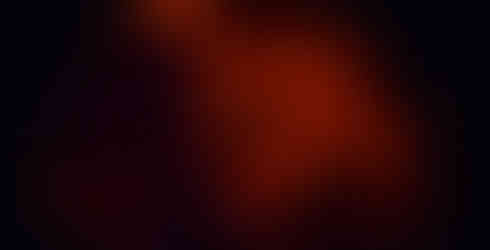Franklin Super Diggg 2017, Trip Report
- Chris Clemens
- Feb 12, 2015
- 9 min read
by Chris Clemens
6/8/17
The promise of this year’s Super Diggg on April 29th was too tempting to resist- over six million pounds of Mill Site rock material, purported to contain copious amounts of rare fluorescent Parker Shaft minerals, would be made available to collectors for the first time since the late 1980’s, with the added enticement of the opportunity to collect on the Buckwheat Dump at night. To quote the travel brochure, this will be “The last great hope of collecting Parker Shaft Minerals from Franklin, NJ.” Upon hearing this, I made the decision to not miss this last in a lifetime opportunity, and to drive the 600 miles from my home in Northwest Indiana to attend my first Super Diggg in Franklin, New Jersey!
The backstory on the Mill Site rock material is that it originally resided at the site of the old Franklin Ore Mill, and contains material that was used for the emergency repair of a damaged rail trestle at the Mill Site. Due to the urgency to complete the repair quickly, the required fill material was obtained directly from the Parker Shaft and other areas, meaning it contained mine run material and not just waste rock. In the past, rare Parker Shaft minerals have been found in this Mill Site material, appearing to confirm the story of its origin. In 2007, construction of a senior citizen’s apartment building was begun at the location of the Mill Site material. Forward-thinking Franklin locals coordinated with the construction company for the relocation of the Mill Site stock to a closed area on the property of the Franklin Mineral Museum, thus conserving this precious resource of rare fluorescent minerals for future collecting. Since 2007, the Mill Site pile sat idle until the week of this year’s Super Diggg. [https://www.mindat.org/loc-250796.html]
During Super Diggg 2017, collecting on the Mill Site pile was done on a limited basis in three separate “Premium” shifts. Each shift allowed only 75 collectors into the closed, fenced-in area, and lasted for 3 hours. On the night that online registration opened for the Super Diggg, I stayed up until midnight to be one of the first to register, to insure a spot in the first collecting rotation of the day.
It had rained heavily up until 4 AM the night before the Super Diggg, but the storm moved out hours before collectors started lining up for the start of the first premium shift at 9. The night’s rain had the benefit of tacking down the dust in the collecting area. My wife Kristine helped me carry my load of collecting gear down to the line, and we were amazed at the variety of improvised UV lamping boxes and hand carts devised for hauling collecting equipment and rocks that we saw lined up at the gate. Lamping set-ups ranged from the classic grill covers and black-painted refrigerator boxes to very well-designed portable units consisting of PVC pipe frames with black cloth covering. Fluorescent mineral collectors are an ingenious group! At 9 AM sharp the gate was opened, letting in the flood of the first group of 75 collectors. Everybody found a spot to call their home base around the perimeter of the pile, and the rock breaking and lamping began! I set up next to the dynamic collecting team of Steve and Heather Hutchcraft from California.

The pile of premium Mill Site material awaits on the other side of the fence, and the eager collectors begin to line up in anticipation of the gate opening at 9 AM.
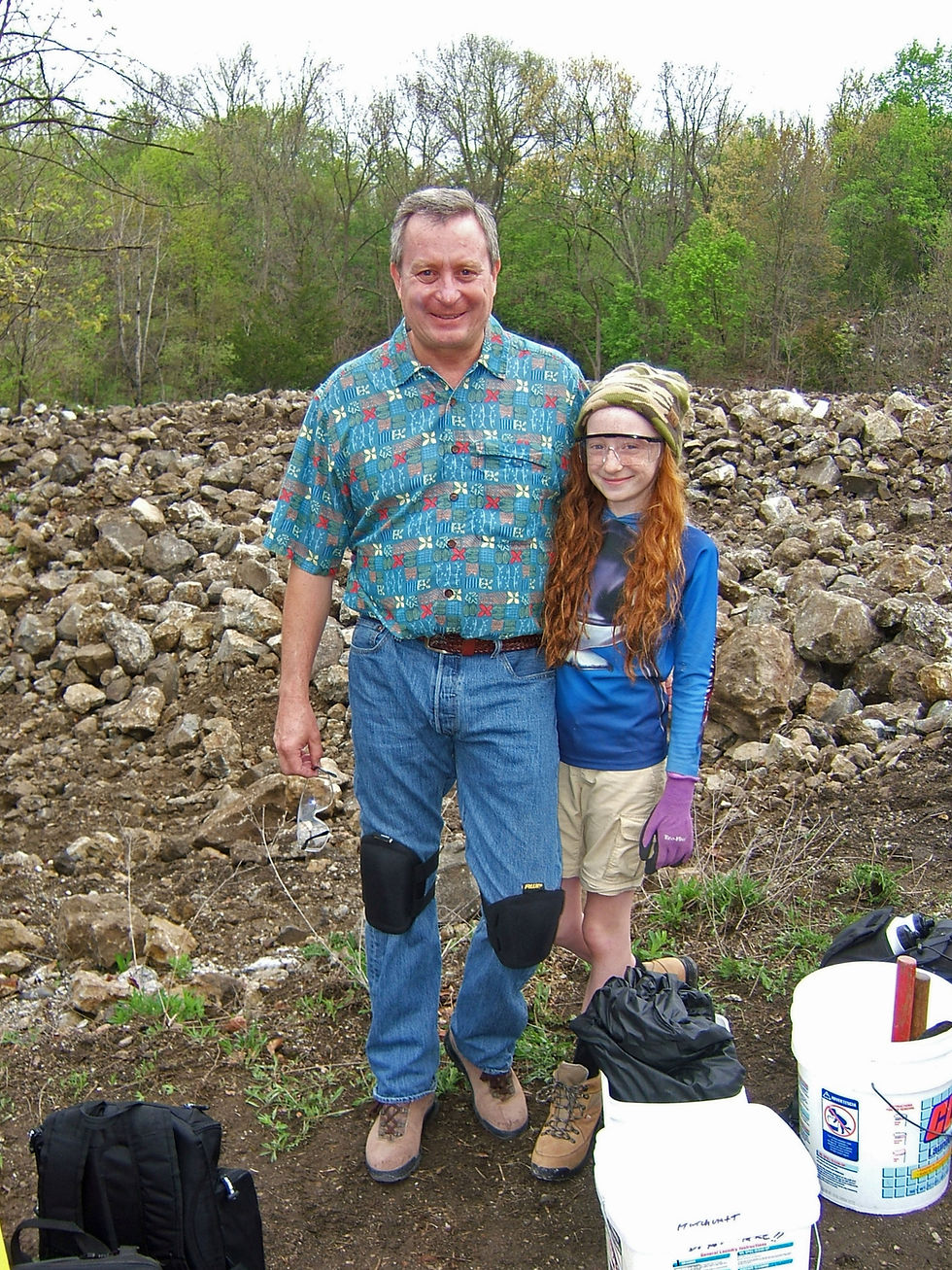
Team Hutchcraft, Steve and daughter Heather. The Buckwheat dump is in the background.
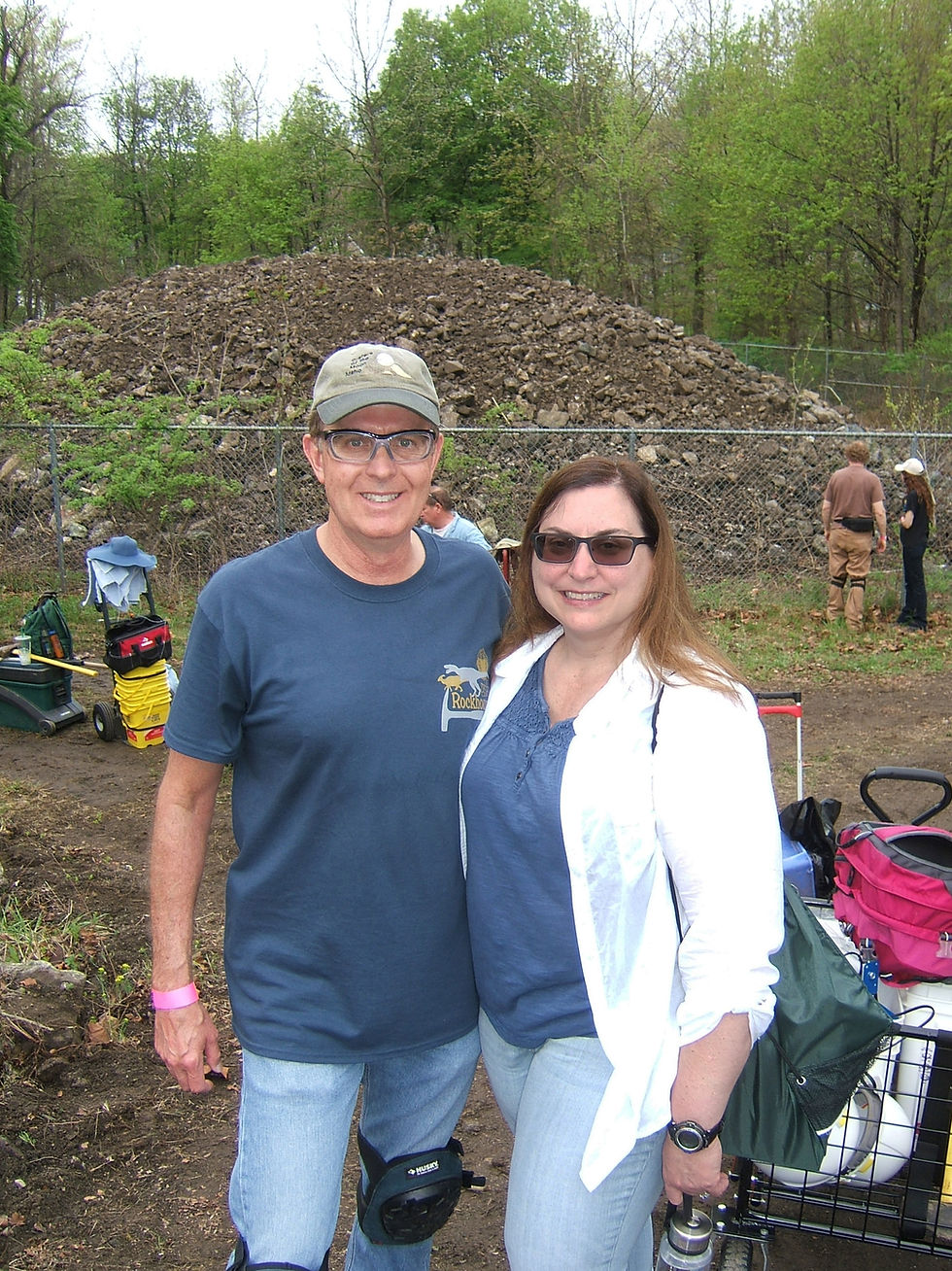
Chris and Kristine Clemens wait for the gate to open at 9. The pile of premium Mill Site rock beckons in the background.

And the collecting begins! Action from Premium session 1 as the first 75 glowhounds scour the pile for elusive Parker Shaft minerals. The size of the material ranged from rocks of a couple inches in size up to boulders of several hundred pounds.
It became immediately apparent that it would be necessary to work hard for worthy specimens. Because the Mill Site pile had been turned-over and spread out a few days before the event, everything was covered with a layer of mud and dust, making it nearly impossible to lamp the surface of anything just picked up off the ground. It was therefore necessary to break rock to find out what fluorescent treasures might lie under the dirty surface of this material. My strategy was simple- I randomly sampled rocks from ground level and on up to the top of the pile, brought them back to my home base, cracked them open, and lamped them under my grill cover.
From the start, I saw a lot of orange and green fluorescence under my grill cover. Common fluorescent calcite, and to a lesser extent willemite, was everywhere. I broke a lot of rock and saw a lot of orange and green! At one point under the grill cover, I saw a bright blue/white fluorescent object crawling across the surface of one of my rocks. It turned out to be a Deer Tick. Who knew that they were brightly fluorescent! I should have gotten a photo. A little while later I found another one crawling on my pant leg. Luckily that was the last one I saw. I’m still hoping I didn’t bring any home with me!

More Premium Session 1 collecting action. The lamping tent and check-out area can be seen at left.

The collecting continues! After and hour and a half, we hadn't even put a dent in the pile. This material will last for years.
After 3 hours of this routine, I accumulated 31 pounds of material that I thought was worthy of buying at $3 per pound. The majority of my rocks were orange fluorescent calcite and green fluorescent willemite. I found a few nice combo pieces containing both minerals with interesting patterns of fluorescence. My best finds were a good sized piece of very brightly fluorescent solid brown willemite, and several nice sphalerite specimens containing combinations of orange and pink long wave fluorescence/phosphorescence with numerous dots of sky-blue fluorescent cleiophane. I also found several combo pieces containing blue-fluorescent microcline with calcite and willemite. Although I thought I might have found a few hardystonite specimens, after cleaning them up and lamping them under better conditions, alas there was no blue fluorescence. Talking with other collectors, it seemed that my experience was typical of what other people found. I heard reports of a couple of very large hardystonite boulders being found, some gemmy willemite, clinohedrite, and nicely-formed non-fluorescent andradite garnet crystals, but did not hear of any finds of the most elusive of the rare Parker Shaft minerals, such as esperite, cuspidine, or margarosanite.
After my session ended at noon and I paid for my finds, I met up with Kristine and we grabbed some lunch at a local Franklin diner- the Sit n’ Chat. The food was great, and the portion size was beyond belief!
After re-fueling, we headed back to the Franklin Mineral Museum to catch the afternoon tour of the Buckwheat open pit and the Trotter property. Ever wonder what’s on the other side of that fence across the street from the Franklin Museum? This was your chance! Led by Dr. Earl Verbeek and others, the tour began at the gate in the fence across from the museum, and we were lead to an overview of the original Buckwheat open cut mine. Now largely filled with water, the present day Buckwheat pit now looks like a beautiful high alpine lake in the mountains, surrounded by towering cliffs and trees. The property is currently privately owned, and is used for parties and recreation. The remaining exposure of the Franklin ore body is still visible in the rock face looking north toward the far end of the lake. We were then led beyond the far north end of the pit to the capped tunnels of the Trotter mine and beyond. Dr. Verbeek provided excellent descriptions of the geological processes and timeline that resulted in the formation of the Franklin ore body, and pointed out numerous exposures of rock of geological significance.
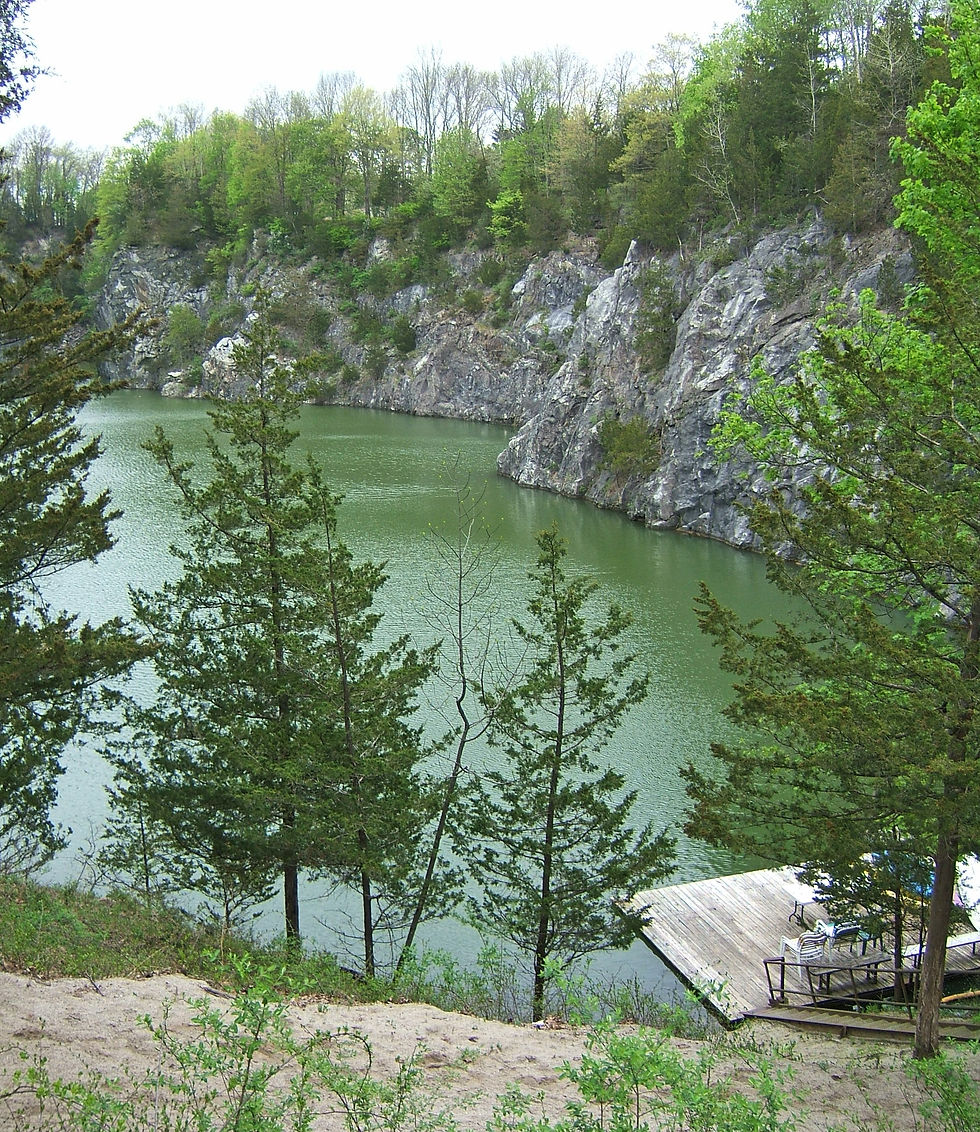
View of the flooded pit of the Buckwheat Open Cut, looking northeast. Today it looks more like a serene high alpine lake than one of the most mineralogically significant locations on earth.

Panoramic view of the entire southern portion of the flooded Buckwheat Open Cut, looking northeast.

View looking north toward the neck that separates the southern and northern parts of the Buckwheat Open Cut.

Aerial view of the flooded Buckwheat Open Cut pit. North is at top. The Franklin Mineral Museum is just out of frame at lower left. Image courtesy of Google Earth.
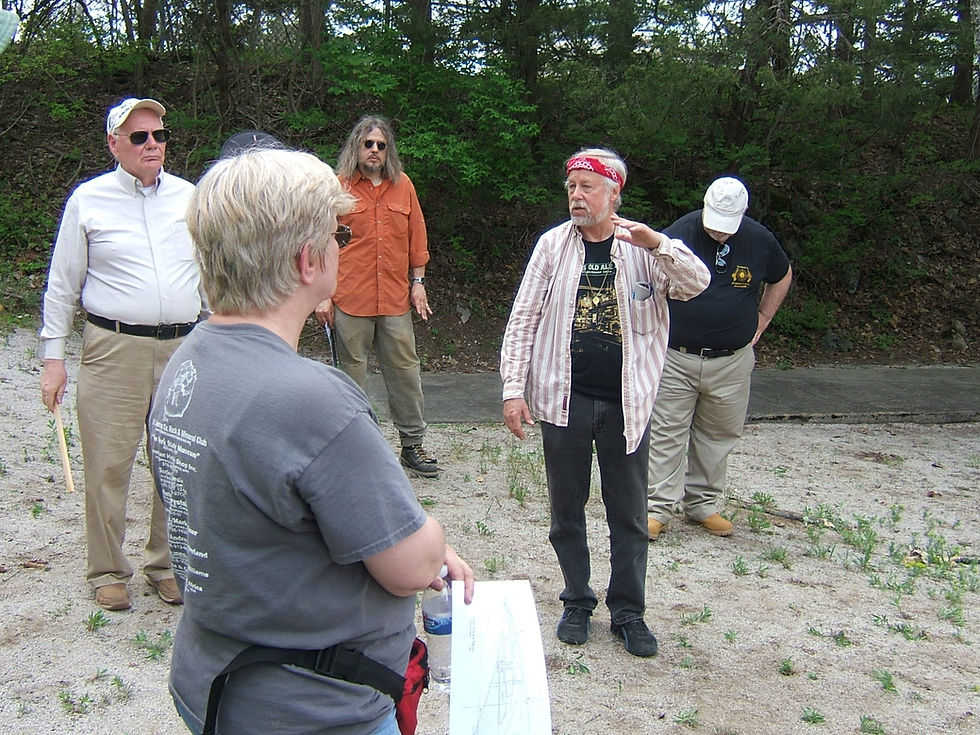
Dr. Earl Verbeek (in red bandana) provides an informative geological perspective on the Buckwheat area and Franklin ore body.
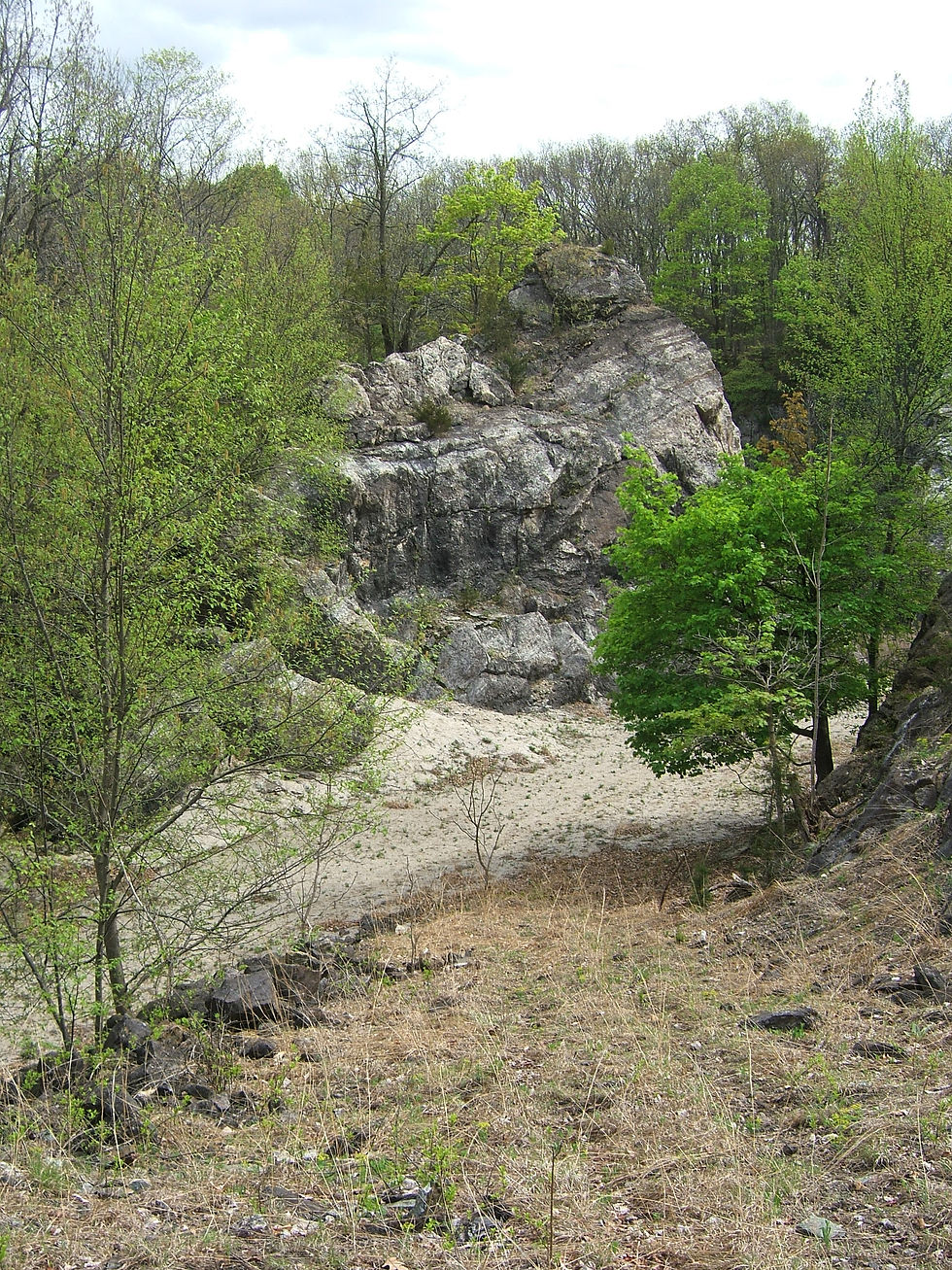
Rock outcrop to the north of the Buckwheat Open Cut, in the vicinity of the Trotter mine.
After the tour, we did a little more light collecting on the Buckwheat dump while we waited for the sun to set for the night dig, and found a few more nice calcite/willemite combo pieces. When darkness finally arrived, we fired up our field lamps and did some night collecting. I used my 18 watt Way Too Cool SW/LW dual wave lamp, and Kristine used her trusty Convoy S2+ LW flashlight. I was expecting the entire dump to light-up under our lamps, but was disappointed to find the same problem as encountered earlier in the day on the Mill Site pile- the dump had been turned over a couple of days earlier, and nearly everything was covered with a coating of dry mud and dust. This meant more rock breaking to see fluorescence! After another hour and a half of collecting, we came away with another 36 lbs. of material, including some bright calcite/willemite combo specimens, and some nice brightly phosphorescent willemite pieces. Using the trusty Convoy LW flashlight, Kristine found the best pieces of the evening, including some 3-color sphalerite specimens, and very interesting multi-wave calcite that fluoresces pink under SW and blue under LW. Between the day and night collecting, we picked up enough material to keep me busy photographing specimens for the foreseeable future! After a tick check and shower back at our room, we enjoyed a well-deserved dinner of Mexican food, and crashed for the night.
Before hitting the road the next morning, we attended a meet and greet for visiting FMS members, organized by Howie Green and the NERFS, in conjunction with the Franklin Spring Mineral show at the Franklin School. Not only was this a great opportunity to meet other like-minded collectors and share stories of the previous day's collecting action, but the world-class fluorescent displays at the show were not to be missed! Thanks so much to Howie and the NERFS for organizing this wonderful get-together.
After getting our specimens home and cleaned, I photographed some of the better pieces. The following pictures show our most interesting finds:
This specimen, consisting of orange fluorescent calcite, green fluorescent willemite, and grains of non-fluorescent franklinite, is representative of the majority of the material found on the Mill Site pile. The size of this piece is 11.5 x 8.4 x 7.1 cm. The willemite veins are phosphorescent. Mouse over the scrolling images for wavelength information.
Large fist-sized specimen of willemite with patches of non-fluorescent andradite garnet. Collected on the Mill Site pile. Mouse over the scrolling images for wavelength information.
Sphalerite in a groundmass of calcite, collected on the Mill Site pile. Under short wave UV the calcite dominates with red/orange fluorescence typical of the Franklin location. Under long wave UV the sphalerite comes to life showing beautiful orange and pink fluorescence with numerous bright dots of the blue-fluorescing variety of sphalerite- cleiophane. The regions of orange sphalerite fluorescence also show bright and lasting phosphorescence. This specimen measures 8.0 x 6.5 x 4.6 cm. Mouse over the scrolling images for wavelength information.
Orange fluorescent calcite and sky-blue fluorescing hydrozincite collected from the Mill Site pile. This specimen measures 11.9 x 7.5 x 5.6 cm. Mouse over the scrolling images for wavelength information.
Another specimen collected from the Mill Site pile, containing lavender-fluorescing microcline, green fluorescent willemite, and minor orange fluorescing calcite. An unknown mineral shows a white phosphorescent response after short wave UV. This piece measures 9.4 x 7.5 x 6.5 cm. Mouse over the scrolling images for wavelength information.
This is perhaps the most interesting specimen that we collected during the Super Diggg. My wife Kristine found this unique calcite during the night dig on the Buckwheat dump. It shows a reverse Terlingua-type fluorescent response under UV- pink/red under short wave and blue under long wave. She found a total of 3 pieces of this material, and this one showed the brightest blue response under long wave. The size of this specimen is 8 x 6 x 6 cm. Mouse over the scrolling images for wavelength information.
This is another specimen found by Kristine during the night dig on the Buckwheat dump. Beautifully fluorescent under all UV wavelengths, it contains an assemblage of willemite, sphalerite, franklinite and other unidentified non-fluorescent minerals. Under short wave UV, the willemite fluoresces green and the sphalerite orange and pink. The sphalerite is brightest under long wave, showing a mixed-color response of orange, pink and blue with pink phosphorescence. The size of this specimen is 8.1 x 5.7 x 3.8 cm.
Although I didn’t come home with the cornucopia of rare fluorescent Parker Shaft minerals that I had hoped for, the best part of attending the 2017 Super Diggg was the opportunity to meet and collect with many of the wonderful people active in our hobby, and I’m already planning my collecting strategy for next year’s event!


















